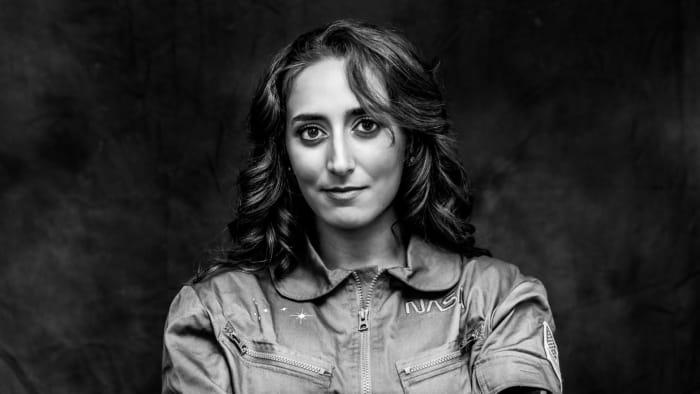Sarafina El-Badry Nance Is Leading the Charge As a Women’s Health Advocate

Sarafina El-Badry Nance.
Courtesy of Sarafina El-Badry Nance
It’s impossible to classify Sarafina El-Badry Nance in one box, and that’s the way she prefers it. The astrophysicist and analog astronaut not only uses her platform to encourage young women and girls to pursue careers in STEM fields, but also embraces the power of storytelling in the hopes of helping other women feel empowered to take charge of their own health.
When Nance was 23, her father was diagnosed with metastatic prostate cancer. Shortly thereafter, she learned that her dad carried the BRCA gene mutation, which meant an increased cancer risk for Nance herself—particularly breast cancer.
“After his diagnosis, I also got genetic testing because it’s a hereditary cancer mutation and [I] learned that I also carry it,” she says.
At age 25, Nance had a biopsy after an MRI screening showed a spot that required further investigation. While it turned out to be benign, Nance’s doctors wanted to begin monitoring her closely every six months—which didn’t fit with her plans for herself.
“I realized that was not the way that I wanted to think about this diagnosis and approach my life and I really wanted to be proactive rather than reactive,” she shares.
Nance, who was a 2022 Swim Search finalist, chose to move forward with a preventative double mastectomy at 26 that she says reduced her risk of breast cancer from 87% to less than 5%.
“It was really a decision for me to take my health into my own hands and make decisions to empower me to live with this high risk in a way that felt manageable,” she says.
Nance felt isolated going through that experience at such a young age. She says she sought out a community in order to connect with others going through the same thing, but it didn’t exist—so she took it upon herself to create one.
“I’m a researcher, I’m a scientist, and if I’m struggling with trying to assemble information, I can’t imagine what it must be like for other people who have an active cancer diagnosis or who have families or who have other things on their plate where they can’t devote this amount of time to learning about what they should do,” she says of her thought process at the time.
Nance adds that as she was trying to find a surgeon and deciding what types of surgeries she needed, there also wasn’t much information available in terms of what patients should do next.
“I wanted to share my journey so that I could empower others to make self-assured decisions about their health, and also to provide information to others who may not have heard of genetic testing or heard of genetic mutations,” she says. “From the moment that I started sharing it, I had this overwhelming response of people who were too scared to go to a doctor or go to a genetic counselor, but my story empowered them to make that decision or empowered them to have difficult conversations with their family about their family health history.”
Sharing her story as a breast cancer previvor felt important, and she says doing so was a way to bring beauty and positivity to a truly difficult situation.
“I felt like I was making a difference and for me, if I can just inspire or empower one other person to make a decision that will help them in their life, then I know that it was worth it,” she adds.
In addition to leading the charge as a women’s health advocate, Nance is invoking powerful change to the ways young women and girls approach careers in science, technology, engineering and math.
While facilitating conversations by sharing her own story and elevating the voices of others is a key part of how she leverages her platform, Nance also partners with brands like Columbia Sportswear and Intuitive Machines that provide tangible financial resources for women looking to break into STEM.
The two companies have combined forces to create a new scholarship program for students at Embry-Riddle Aeronautical University that will award $200,000 worth of funds to undergraduate and graduate students.
Additionally, Intuitive Machines will send its Nova-C lunar lander to the moon this month to gather information using the EagleCam, a piece of equipment that was designed by students at Embry-Riddle. The camera will deploy off the side of the lunar lander before it reaches the surface of the moon, capturing what will be the first third-person footage of a moon landing.

Nance in Columbia Sportswear.
Sarafina El-Badry Nance
The spacecraft will be protected from extreme temperatures thanks to Columbia’s Omni-Heat™ Infinity thermal-reflective technology.
“The Omni-Heat technology that’s used in [Columbia Sportswear’s] jackets, vests and boots is exactly what’s being used to insulate the Nova-C lunar lander that is marking America’s first return to the moon in 50 years, so that’s a really historic moment in our country’s history,” Nance shares. “It’s something that I’m really excited to be a part of that’s very much in line and in tandem with my research efforts.”
Nance will release her memoir, Starstruck: A Memoir of Astrophysics and Finding Light in the Dark, in June. She expects to graduate with her Ph.D. in astrophysics from the University of California in December.
